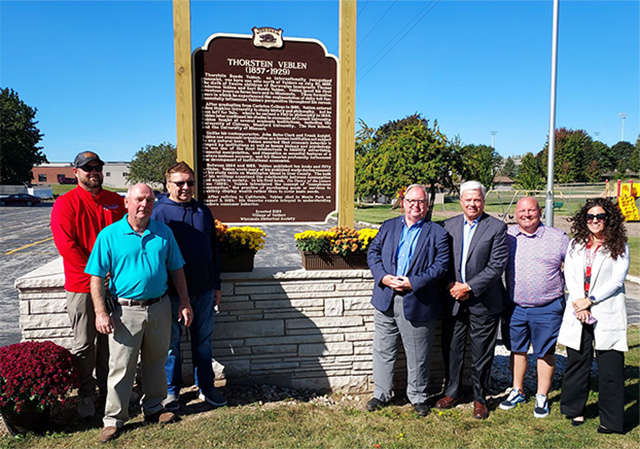History of Valders, Wisconsin

Dedication of a new Historical Marker in the Village.
From left: Devan Schneider (Village President), Daniel Sabel & Lyle Schwoerer (Village Trustees), Christian Overland (Ruth & Hartley Barker Director and CEO, Wisconsin Historical Society), John Thompson (Board of Curators Member, Wisconsin Historical Society), David Schmid (Principal, Valders High School), Kristin DeTroye (Superintendent, Valders Area School District).
About Valders
Valders, a progressive community, can trace its name and heritage to Norwegian immigrants who settled in Manitowoc County in the 1840's. But the community might not exist had it not been for the railroad and the church.
A large number of settlers began arriving from the Valdres area of Norway, establishing a Lutheran congregation. The first church (octagonal shaped) was built in 1853, but before its location could be decided, there was a controversy which needed to be settled. To decide the issue, Ole Gigstad and Thomas Thompson Helle were to chop down a tree. Gigstad was known to make an ax ring. Gigstad's tree fell first and gained the right to chose the location of the West Church along Highway 151.
Valders did not begin to come together as a community until almost the turn of the century. About 1890, Wisconsin Central Railroad decided to establish railroad service to the small towns between Manitowoc and Hilbert. When they came to purchase the right-of-way, some landowners in Manitowoc Rapids and Clarks Mills refused to sell for the price offered. The surveyors then plotted a line further south, where the present tracks are now located. The right-of-way was purchased and construction began in 1894. Construction was completed in 1895, and service began for passengers, mail and freight. A depot was then constructed, a railroad official then asked the farmers what this new place should be called. No one at the meeting could think of an appropriate name. The officer saw a church steeple and asked its name. The farmers replied "the Valders Church", the official thought it was a splendid name, thus the town of Valders became named.
In the spring of 1897 the town began to take shape. Joseph Zipper built the Central Hotel, and Otto G. Berge bought a lot from Mr. Boyton and began construction of the Valders Hotel. In 1898, the first house was built by Mr. Evenson. The home is now owned by James Barnes. Berge also built a post office and a general store. Also in 1898, Otto Berge and Knute Sebo established the first undertaking parlor.
Other industries and business began to spring up after the first few settlements were made. These included Valders Elevator in 1904, and the Gjerpen-Valders Telephone Co. and Valders Lime & Stone in 1905. In 1905, Otto Olson opened the first livery barn. In 1907 Christel and Luellof Grocery Store opened. In 1908, Oslo Light & Power Co. began to supply electricity to Valders.
In 1910, a farm implement business was started by Martin Helgeson and the Valders State Bank was organized in 1911. Also in 1910, William F. Christel established one of the first Ford automobile dealerships in the state. Christel also established the Valders Canning Co. in 1914 and the facility operated until 1963.
In 1916, T.G. Larson and sons established an automobile agency and sold Buick and Oakland cars, later adding Chevrolet. Tony Gintner opened a bar, ice cream parlor and two bowling lanes in 1917.
Valders was incorporated as a village in late 1919, and the first election was held on Jan. 13, 1920. At that time, William F. Christel was chosen president and six other men served as trustees.
Public education came to Valders in 1906, when a two story frame building was constructed for $2,500 on the north side of the town. A four year high school was established after a two stroy brick building on Jefferson Street was completed in 1922. The first class graduated in 1924.
For a more complete history of the Village (1897-1997) history books are available at the village office for $2.00.
